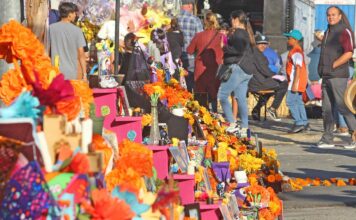While most Gilroyans are familiar with that Hecker Pass landmark, The Barn at Hoey Ranch, in the future you may want to refer to the BarnS at Hoey Ranch.
The well-known antique and collectibles emporium is owned by Jim and Debbie Hoey, part of the 5th generation to live and work on the ranch and purveyors of “….everything from iceboxes to jukeboxes, from vintage furniture to farm equipment.” The ranch, though, belongs to an extended family—from mother Estelle Gragg-Hoey, to daughter Barbara Hoey-Armenta, as well as to daughter Marjorie Hoey-Siverson, and has been held by the same family since the 1850s.
Once part of the Solis Rancho, a land grant of about about 9,000 acres awarded to Mariano Castro in the early 1800s by the Mexican governor of California, the ranch began as a 630 acre parcel then swelled to about 1,200 before coming to its present size of 530 acres.
The Hoey’s ancestors, Samuel & Electa Ousley and their nine children, came to Gilroy in 1854 and settled into raising cattle along Hecker Pass Highway/State 152—then known as Bodfish Mill Road. At this time, as California became part of the United States, titles to the Solis Rancho were in dispute. Still, the Ousleys settled, expecting to pay when titles were cleared. Rancho owners, of the Spanish/Mexican era “Californios”, believed settlers like the Ousleys were encroaching and their riders harrassed families, so rural parents were inclined to make their children stay near home. Though titles were cleared in 1859, only 20 years later Henry Miller sued many local land owners because he claimed ownership of their land. Miller won his suit against the Ousleys, and they had to buy back about half of the acreage that was part of the Las Animas Rancho. Fortunately a large portion of the Ousley’s landholding was in the Solis Rancho, which was not involved in the Miller law suit..
Personal tragedy befell the family even before the settlement of Miller’s lawsuit. Samuel Ousley died in 1855, and Electa was faced with raising the family even as she ran the ranch. With help from her children, John and Porter, she was soon able to more than double the size of their ranch. Electa also diversified and ultimately they were raising prunes, grapes, and—in the 1870s tried growing & curing tobacco for local cigar factory, but imported tobacco smothered the market for local growers and the Ousleys gave up that venture.
Eventually the Ousley ranch included a creamery, barracks for as many as 25 hired hands, a granary, and more barns for horses & hay because horses worked the ranch till the late 1920s.
In the 1870s, the City of Gilroy purchased several acres from Electa’s daughter, Emma Ousely, who had by then married Francis Hoey, to build a reservoir for water from Uvas Dam—this was the primary water storage till 1970 when it was filled after storage tanks were built above Santa Teresa Boulevard.
In 1925 Electa’s daughters, Mary and Clara, leased about 36 acres to the City for a golf course. After Mary Ousley’s death in 1936, the land was gifted to they City under the provision it would remain a golf course.
After Mary Ousley died, twin brothers Ed and William Hoey bought the ranch from the nine other heirs. In 1928 Hecker Pass Highway was dedicated and the family—whose ranch was always divided by Bodfish Mill Road—found itself facing much heavier traffic. After 1941, much of the land north of the Highway was returned to grazing. Around 1948, after his return from World War II, Edward Hoey planted prune, walnut, and pear orchards south of the Highway.
The Ousley/Hoey house was built in 1872 and is the oldest structure on the ranch. It is located about 50’ from the original house and is built of redwood logged on Mount Madonna. The house’s 4,400 sq. ft. cost an estimated $3,500 to build.
• this information was derived from Maureen Frantzich’s
article in Gavilan College’s 1980 “Sketches of Gilroy”
of rust and lichen and morning dew,
of hardy structures that have sheltered you.
amid hills and grass with gentle breeze,
these are the things of memories.
“Barn Again” highlights South County barns and farm buildings, documenting and savoring the beauty and function of our agricultural heritage and sharing the rich stories of community members who own and preserve these treasures.
The author is anxious for contributions and asks readers for suggestions about barns and farm buildings to feature, photos and information about past and present barns, and about agriculture-related collections like milk bottles, tractors, tools and more.













